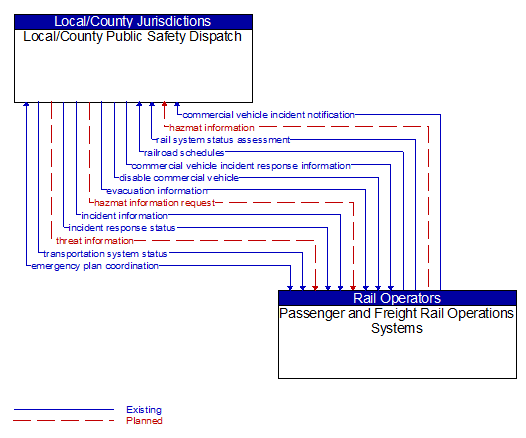Interface: Local/County Public Safety Dispatch - Passenger and Freight Rail Operations Systems

Architecture Flow Definitions
commercial vehicle incident notification (Existing) Applicable ITS Standards
Information about a Commercial Vehicle or Freight Equipment breach, non–permitted security sensitive hazmat detected at the roadside, route deviation, or Commercial Vehicle Driver / Commercial Vehicle / Freight Equipment assignment mismatches which includes the location of the Commercial Vehicle and appropriate identities.
commercial vehicle incident response information (Existing) Applicable ITS Standards
This flow provides data containing an acknowledgement of the commercial vehicle incident notification and provides post–incident instructions.
disable commercial vehicle (Existing) Applicable ITS Standards
A request that a specific commercial vehicle should be safely disabled.
emergency plan coordination (Existing) Applicable ITS Standards
Information that supports coordination of emergency management plans, continuity of operations plans, emergency response and recovery plans, evacuation plans, and other emergency plans between agencies. This includes general plans that are coordinated prior to an incident and shorter duration tactical plans that are prepared during an incident.
evacuation information (Existing) Applicable ITS Standards
Evacuation instructions and information including evacuation zones, evacuation times, and reentry times.
hazmat information (Planned) Applicable ITS Standards
Information about a particular hazmat load including nature of the load and unloading instructions. May also include hazmat vehicle route and route update information.
hazmat information request (Planned) Applicable ITS Standards
Request for information about a particular hazmat load.
incident information (Existing) Applicable ITS Standards
Notification of existence of incident and expected severity, location, time and nature of incident. As additional information is gathered and the incident evolves, updated incident information is provided. Incidents include any event that impacts transportation system operation ranging from routine incidents (e.g., disabled vehicle at the side of the road) through large–scale natural or human–caused disasters that involve loss of life, injuries, extensive property damage, and multi–jurisdictional response. This also includes special events, closures, and other planned events that may impact the transportation system.
incident response status (Existing) Applicable ITS Standards
Status of the current incident response including a summary of incident status and its impact on the transportation system, traffic management strategies implemented at the site (e.g., closures, diversions, traffic signal control overrides), and current and planned response activities.
rail system status assessment (Existing) Applicable ITS Standards
Assessment of damage sustained by rail lines and associated railroad infrastructure including location and extent of the damage, impact on current operations and necessary restrictions, and time frame for repair and recovery.
railroad schedules (Existing) Applicable ITS Standards
Train schedules, maintenance schedules, and other information from the railroad that supports forecast of HRI closures.
threat information (Planned) Applicable ITS Standards
Threats regarding transportation infrastructure, facilities, or systems detected by a variety of methods (sensors, surveillance, threat analysis of advisories from outside agencies, etc.
transportation system status (Existing) Applicable ITS Standards
Current status and condition of transportation infrastructure (e.g., tunnels, bridges, interchanges, TMC offices, maintenance facilities). In case of disaster or major incident, this flow provides an assessment of damage sustained by the surface transportation system including location and extent of the damage, estimate of remaining capacity and necessary restrictions, and time frame for repair and recovery.